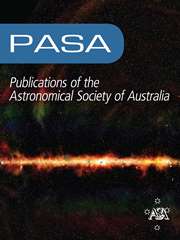No CrossRef data available.
Article contents
Star formation in interacting galaxy systems: UVIT imaging of NGC 7252 and NGC 5291
Published online by Cambridge University Press: 01 April 2025
Abstract
Interactions play a significant role in the formation and evolution of galaxies in the Universe. The galaxy systems, NGC 7252 and NGC 5291 are two nearby interacting systems that are hosting Tidal Dwarf Galaxies (TDGs) and star-forming knots. The present work aims (a) To determine the attenuation-corrected star formation rate (SFR) of the interacting system NGC 7252 (b) To compare the star formation in the NGC 7252 system with that of the NGC 5291 system (c) To explore the relation between surface densities of gas and SFR in these two systems. The study utilises high-resolution FUV and NUV imaging data from the Ultraviolet Imaging Telescope (UVIT) on board AstroSat. Six star-forming regions, including the merger remnant, were identified in the NGC 7252 system. The SFR corrected for attenuation of the knots in the NGC 7252 system is determined using the continuum slope β calculated from the FUV-NUV colour. It has been observed that the attenuation-corrected SFR values of the knots in this system fall within the range of SFR values determined for the NGC 5291 knots. The TDGs in both systems adhere to the same Kennicutt-Schmidt (KS) relation as regular spiral galaxies.
Keywords
- Type
- Research Article
- Information
- Creative Commons
- This is an Open Access article, distributed under the terms of the Creative Commons Attribution licence (https://creativecommons.org/licenses/by/4.0/), which permits unrestricted re-use, distribution and reproduction, provided the original article is properly cited.
- Copyright
- © The Author(s), 2025. Published by Cambridge University Press on behalf of Astronomical Society of Australia


